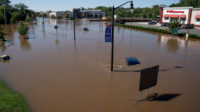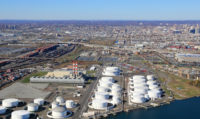Environment
Groups Counter NJ 'Emergency' Flood Construction Rules

New Jersey Gov. Phil Murphy's plan to implement emergency rules for new construction in flood-prone areas of the state has generated pushback from business, development and municipal groups.
The rules would raise official flood plains in non-tidal areas by 2 ft, require use of future rainfall projections and toughen stormwater management steps.
Expected to take effect on June 9, the plan will address what the NJ Dept. of Environmental Protection describes as an “imminent peril” to public health and safety. Noting major inland flood impacts from Hurricane Ida last September and other recent storms, the agency points out that current rainfall rates are more than 20 years old.
Hurricane Ida brought historic levels of rain and deadly inland flooding that killed 48 people in the Northeast and Mid-Atlantic regions.
“The state’s reliance on data that looks backward from the year 1999 is no longer sufficient to ensure the continued protection of homes, communities, economies, and people,” DEP spokesman Larry Hajna said June 7 in a statement. The rules apply only to future development and redevelopment projects.
Officials say the updated requirements are a modern approach to how the state regulates development in inland areas that frequently flood with stormwater runoff as opposed to tidal flooding in oceanfront areas.
But in a June 7 letter to Murphy and state legislators, the New Jersey Business & Industry Association and 18 other business and municipal groups urged a halt to use of an emergency rule process to immediately implement a flood-control plan.
Other signatories include the Engineers Labor-Employer Cooperative (ELEC 825), NAIOP New Jersey, New Jersey Association of Counties, New Jersey Apartment Association, New Jersey Builders Association, New Jersey Concrete and Aggregate Association, New Jersey Society of Professional Land Surveyors, New Jersey Utilities Association and the Utility & Transportation Contractors Association.
New State Flood Rules Could Be 'Disastrous'
“It could be disastrous,” said Ray Cantor, the association's vice president of government affairs in a statement. The planned changes, he claimed, "could lead to thousands of already approved development and infrastructure projects being delayed or canceled.”
Cantor said limited grandfather provisions in the rule will have “dire economic consequences” on potentially thousands of projects, including low-income housing.
“Projects in areas that were never part of a flood hazard area before, many of which have legal determinations that they were not in flood hazard areas, will now need flood hazard permits for the first time,” the business and municipal groups pointed out.
They said DEP has provided no maps or analysis to show specific areas or projects that will be affected, with Cantor estimating that as much as 5% to 10% of the buildable area of the state, estimated at about 200,000 to 400,000 acres, will be impacted by the emergency rule.
State flood maps need to be updated, the groups said, but the primary problem is inadequate stormwater facilities.
While state law allows an agency to make emergency amendments to administrative code after a finding of imminent peril, the opposing groups said the rule should be proposed through the normal administrative process. The process, the groups said, "will allow for the public to adequately comment, for equities and impacts to be evaluated and planned for, and to minimize economic disruptions and legal challenges."
New rules become effective after filing to the state Office of Administrative Law and are valid for 60 days.
NJDEP said it will file both the emergency rule-making and a concurrent proposal to enable emergency provisions to remain in place past 60 days. Both will be published in the New Jersey Register, followed by a 30-day comment period.
In a statement, a Murphy spokesman said that as the state faces more extreme weather events, its government "will continue to respond to the worsening climate crisis with evidence-backed solutions and investments."



